
"Sporting Clays in Style: Barnsley Gardens" in Portico Magazine, September 2008
“Arizona's Other Canyon” in the Chilliwack Times, November 2, 2007
"Haunted Hotels" in Portico Magazine October 2006
"Lost Time at the Victoria-Jungfrau" at Go World Travel (March 2004).
Excerpted from Portico Magazine, September 2008:
You remember that weekend you spent at your high school buddy’s country estate. A sweet little guest cottage, very private, meals magnificently prepared by a gold medal chef, a little sport shooting and fishing, a round of killer golf at his club.
No? You don’t have a buddy with a country estate? Banish that thought. Now you do. And the estate was developed by a prince, if you can imagine that. Not just a nice guy, but bona-fide European royalty.
The luxury resort Barnsley Gardens in North Georgia is little more than an hour away from Atlanta by car. But you can come in your private helicopter if you like. In fact, the staff here will accommodate almost any wish with an easy smile.
While there is a spa, an impeccably groomed golf course, extraordinary gardens, clay tennis courts and other extremely civilized entertainments to be found, you can also take to the woods for a different kind of fun.
"Sporting clays came to us from England," says instructor Skip Smith, a calm, soft-spoken man whose weathered face suggests many hours outdoors. "It's very different from skeet and trap shooting, because it simulates hunting more closely. Some people say it's like golfing with a gun."
Wow. What a concept. Golfing with a bang. It's catching on here in the United States, too.
(from Portico Magazine, September 2008. All rights reserved (c) 2008 Karyn Zweifel)
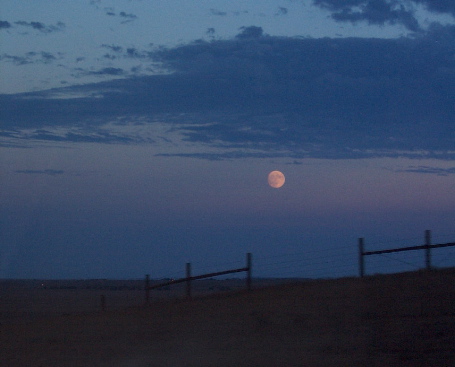 South Dakota landscape at moonrise. Photo by Kathryn Z. Turner.
South Dakota landscape at moonrise. Photo by Kathryn Z. Turner.
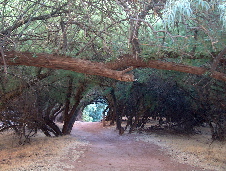
I love to travel. With me, even a trip to the corner store is a chance for adventure. And, of course, being a writer, after every journey I feel compelled to write about my travels.
Every now and then I'll get a wild hair and attempt to make a living (or even enough for dinner) selling my travel writing. I've not found the magic formula yet. If you have it, please share!
In the meantime, I will add a piece here and there to this page, because I like to see my work in print. If you want to republish any of these pieces, please send me an email or call me at 205-251-0806. I'll update as needed and even throw in a picture or two.
I've sold a few pieces online and in print. There is a list of my published travel pieces below.
--Karyn Zweifel
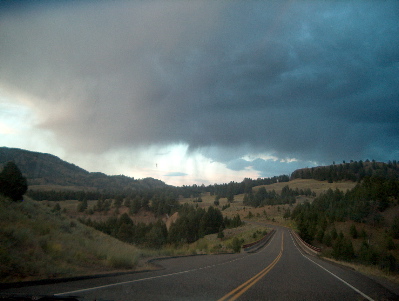
On the road in Yellowstone National Park.
Photo by Kathryn Z. Turner.
Breathtaking. Spectacular. Awe-inspiring. It's no wonder the Grand Canyon is one of the world's most visited spots. But another Arizona landmark, 235 miles to the east, had an equal yet different capacity to steal away my breath and inspire quiet reverence during a recent western road trip. It's the Canyon de Chelly (pronounced "de-shay") near Chinle in the Navajo Indian Reservation.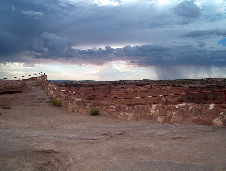
Canyon de Chelly National Monument is actually a series of canyons tucked away in the dry and dusty eastern edge of Arizona. Driving there from Flagstaff, there is an easy parallel to draw between the bleak and treeless landscape and the apparent poverty of the Navajo people. But looking closer, the desert is teeming with life on an unexpected plane. Canyon de Chelly, with its prehistoric pictographs, Anasazi ruins and current-day Navajo residents, offers a glimpse back in time at an endangered culture. It's also a vacation stop relatively uncluttered by cheap gift shops, oversized tour buses and hordes of tourists.
We arrived late in the day, and drove to the overlook for the largest and most accessible canyon, Canyon de Chelly. The canyon walls are sheer and sculpted from a subtle palette of sandstone, ranging from a dramatic red to a pale beige with a rosy tint. The scale of the canyon tricks the eye. A childlike figure is just visible, bent over a row of plants at the canyon floor. Far away on the northern wall of the canyon is a gap in the stone, gradually widening. Only with the help of binoculars do the ancient stone dwellings tucked inside the wall become apparent. They look like toys, or even painted false fronts, hardly likely to have sheltered up to 80 people.
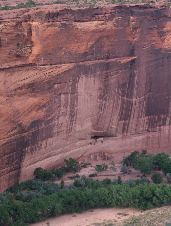 There are only three other cars in the parking lot. A couple of young men, probably Navajo, shyly offer to show us their wares: modern versions of ancient petroglyphs, deftly painted on a chip of red sandstone.
There are only three other cars in the parking lot. A couple of young men, probably Navajo, shyly offer to show us their wares: modern versions of ancient petroglyphs, deftly painted on a chip of red sandstone.
The mesa surrounding the park is true to its name, table-flat. While the sky around and behind us is a sharp and biting cloudless blue, a violent summer storm is some ten miles away, painting the distant landscape with sheets of blue, hazy rain. The roiling purple storm clouds, piled high, move towards us at a stately and unstoppable pace.
We decide to stay at the Thunderbird Lodge instead of pitching our tent at the National Park Service's Cottonwood campground. To avoid the scorching summer heat, we'll begin our explorations as close to dawn the next day as we can manage, leaving the long hot afternoon open for a leisurely lunch and siesta.
Next morning, the dawn breaks over a perfectly clear sky, a little breeze kissing at our heels as we begin to descend into the canyon. The trail is wide and easy, a gentle grade switching back and forth as it lazily winds down some eight hundred feet to the canyon floor. The quiet remains unbroken, our sleepy family of four the only disturbance until a woman and a man of Native American descent jog past us, back up to the canyon rim and the beginning of another workday. Only an hour after sunrise the sun begins to bear down unrelenting on the trail, and it is with relief that we reach the shady canyon floor.
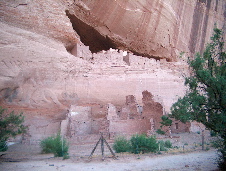 The National Park Service manages the area in cooperation with the Navajo Nation. Because of the cultural and spiritual significance of the ruins and the fact that Navajo families live and make a living within the canyons, unescorted visitors are limited to a single moderately easy hike within the main canyon to the periphery of the White House ruins. To explore the park in more depth, visitors have to apply for a permit and hire a guide.
The National Park Service manages the area in cooperation with the Navajo Nation. Because of the cultural and spiritual significance of the ruins and the fact that Navajo families live and make a living within the canyons, unescorted visitors are limited to a single moderately easy hike within the main canyon to the periphery of the White House ruins. To explore the park in more depth, visitors have to apply for a permit and hire a guide.
Now our path is level, cutting past an orchard of gnarled old trees, over rock outcroppings and even through a short tunnel cut through the rock. Watching my feet, I discover a perfect animal track captured in the sandstone, an oversized cat's paw. After careful examination, we are relieved to pronounce the track a relic from long ago. It's fun to place our own "paw" next to the imprint and marvel at what must have been a fearsome beast, a panther or a cougar who shared the canyon with its original inhabitants a thousand years ago or more.
In the United States, a landmark dating back some four hundred years is about as old a marker of European civilization as we can hope for. To walk through signs of a civilization with a thousand years or more of continuous inhabitation inspires a different kind of awe than that evoked by the sheer magnitude of the Grand Canyon, but it is no less memorable.
We come out through the trees to a level plain, dotted with trees and stretching a few thousand feet to the sheer rock face. Enclosed within a wire fence are a few crumbling walls, suggesting a sizable three-story building whose roof and floors are long collapsed. The dwellings were built about a thousand years ago, before the Navajo came, and abandoned inexplicably three hundred years later. The more recent Navajo residents call the original builders "Anasazi" or "ancient ones."
Beyond these ruins, seventy five feet or more above the canyon floor, a cluster of adobe buildings is tucked into a deep crevice. Barely visible beyond the first row of dwellings is a nondescript rectangular whitewashed structure. It carries deep religious significance. A Navajo healing ceremony, nine days long, mentions the "white house" where the thunderbird god lives, a "place between." The fence keeps vandals away and minimizes sacrilegious contact with the sacred spot.
These ruins, like others in the park, are facing south to take advantage of the sun in the long winter months. And today there are native people here by the ruins, too, to take advantage of any tourist dollars that may float to the bottom of the canyon. Flimsy card tables squat under the welcome shade of the cottonwood trees, spread with brightly colored cloth and holding displays of inexpensive jewelry that may or may not be turquoise and other semiprecious stones.
The park holds many other sights, including famed Spider Rock, the Canyon del Muerto (Canyon of Death), Antelope House ruins and Massacre Cave. But the Arizona sun promises to be pitiless, and we straggle back up the trail and retreat to air-conditioned comfort. When afternoon shadows stretch long across the canyon, we return on horseback with a native guide. Edwina is eighteen and not very talkative. She points out a handful of petroglyphs, graphic, evocative stick figures of people and animal scratched deep into the wall. Our six-year-old son gets more pleasure from seeing animal shapes in distant rock formations at the top of the canyon: a turtle, a rabbit.
The horses are swaybacked, pestered by flies. We ride for an hour and return to the stables. They are shabby, with a broken down couch shoved haphazardly onto the porch of an adjoining house. A band of small children peer around the corner and a baby wails inside. Outward signs speak of hardship.
But perhaps this is deceptive, like the view of the canyon floor seen from the rim. This is a culture that has inhabited this particular corner of the world for three hundred years, following the Anasazi who were here for thousands of years before. They are a people with a different rhythm, different values, a different perspective. While it is tempting to dismiss the experience with a flicker of pity and a dash of charity, we can't. Instead we climb into our car and point ourselves east, back to our own civilization, wondering if relics of our own culture will hold as much meaning in a thousand years, or even survive at all.
If You Go: From Flagstaff to Chinle is 212 miles; from Albuquerque, NM to Chinle is 229 miles. Fill up your gas tank when you leave the interstate. There are lots of chain motels in Chinle, but the Thunderbird Lodge is actually in the park and a half a mile from the Canyon de Chelly Visitor Center. The motel was built in the 1950s and is clean and comfortable, but not plush. The restaurant is located in the original trading post built in 1896 and offers ordinary fare and and Navajo-style meals seven days a week. Go to http://www.tbirdlodge.com or call (520) 674-5841 or 674-5842 for reservations or information.
You can also arrange for jeep tours, camping trips or horseback rides from the motel. The locals call the jeep tours "shake and bake," because few roads within the park are paved and the jeeps are open to the sunshine. Hats, umbrellas, sunscreen and water are a necessity.
Seven tips for making multigenerational family travel a good time for all (yes, even for you).
(July 16, 2002)
It was a once-in-a-lifetime opportunity. My dad wanted to take us all to Italy. He wanted his daughters to see Florence, his granddaughter to experience the canals of Venice. I couldn’t wait. I began scheming and planning right away. With the assistance of the internet and a couple of good guidebooks, I was going to make this a trip we’d never forget.
We were a large and diverse party. My dad was 63, in moderately good health but not much of a walker. There was my husband, our eight-year-old-daughter, and me, six months pregnant with a long-anticipated second child. My sister and her new husband came along, as romantically inclined as a pair of cooing doves.
I didn’t know any better than to just throw together an itinerary and make reservations. Like so many of my endeavors, it turned out for the best. Call it serendipity, angelic intervention, or just dumb luck. It works for me. Although we traveled overseas, you’ll find there is a lot of common ground when planning a family trip just down the road or across the world. Here are a few ideas on how to make multigenerational travel work for your family:
1) Make the most of natural affinities. In most of our hotels, I booked our daughter Katy into the same room with my dad. She adores her “papa” and he loves her company. They both had a little trouble keeping up with keys, though, until they figured out that it’s customary in Europe to leave the key at the front desk when you go out.
Since Katy was rooming with my dad, that meant my husband Doug and I had a little privacy. Very nice, even if I did waddle slightly. Jan and Alan needed their own room, being newlyweds. Most of the hotels I chose were moderately priced; they all offered breakfast. The one criteria I stuck to was a hotel staff which spoke English, because none of us had any foreign language skills to speak of.
2) Keep it simple. Planning to take in two sights a day kept us plenty busy. Planning outings for anybody but yourself and (maybe) your spouse is a waste of time. My dad liked to see a city from the windows of a bus, in air-conditioned comfort, with forays from the bus an option. Doug and I liked to wander on foot through the winding streets, losing ourselves in everyday lives. My sister Jan and her husband Alan were ambitious, goal-oriented tourists, with multiple sights packed into a carefully planned day. As soon as I gave up trying to direct traffic (about day two, in Rome), I was much happier and more relaxed.
3) Before you leave, make multiple copies of the agenda with hotel names, dates and phone numbers. Give one or even two to every member of your party. This way, you can share the responsibility of getting to the train station on time with everybody else, and cut down on your own stress level. Also, if someone should get separated, they’ll be able to catch up with you at the end of the day.
4) Build in nap time for the older, younger and pregnant members of the party. My dad could keep on chugging long into the night if he had two or three hours of down time in the afternoon. Quiet time in the room kept fair-skinned Katy out of the sunlight in the hottest part of the day, and even I enjoyed putting my feet up and watching the crowds flow by underneath our window. Sometimes a short siesta is all that’s needed to redeem a difficult day.
5) Have a time set aside every day for the group to gather. For us, dinner time was a can’t-miss event. Especially in Italy, the evening meal is a time to gather, talk, eat and sip wine for hours on end. Scheduling a late dinner meant everybody had time to get there. Then we’d share the stories of our day. It’s our family’s custom to share entrees, too, passing the plate around the table so everyone can savor a bite. One of my favorite memories is a little restaurant in Pisa. Katy’s dad had ordered a rabbit and pasta dish, and Katy liked it so much she asked if she could order it again for dessert.
6) Make allowances for different tastes. Don’t push anybody into going to museums or sights they’re not interested in. This was the most valuable tip I had going into the trip, and I followed it religiously from the beginning. My dad had been to the museums, the historic buildings, the churches. He wasn’t interested in exploring them again. He and Katy had the time of their lives sitting in this little square or that little plaza and feeding the birds. He and Katy could window shop to their hearts’ content and eat whatever they wanted, whenever they pleased. For three days in a row in Florence, they lunched happily at a cheap Chinese takeout place. Go figure.
Doug and I, on the other hand, could take our time in the museums, stroll arm-in-arm as couples should, and try exotic foods at tiny out-of-the-way cafes when the mood struck us. Every time I saw a family with hot, exasperated parents and whiny, unhappy kids tugging to get through with the exhibit or the meal, I smugly congratulated myself.
I wasn’t above a few tricks, however. Katy adores Italian ice cream. Gelato is sinfully rich, creamy and refreshing. Every corner cafe had a white freezer sitting outside, ready to indulge your appetite. On the opposite corner, as often as not, was a church. I am fascinated by church architecture and history, and lured Katy into to every church I could. If she found a painting of the Annunciation (the angel Gabriel announcing the good news to Mary), I’d buy her an ice cream. Of course, practically every church and museum covered this theme, so she picked up quite a bit of art history while satisfying her gelato habit.
7) Take lots of pictures and be sure to include your fellow travelers in every shot. I can’t tell you how priceless the photos of my dad and Katy feeding the pigeons in St. Mark’s Square are to me now. Katy will never be eight again, and the photos have captured a little bit of the joy and love we all shared for fourteen days in Italy.